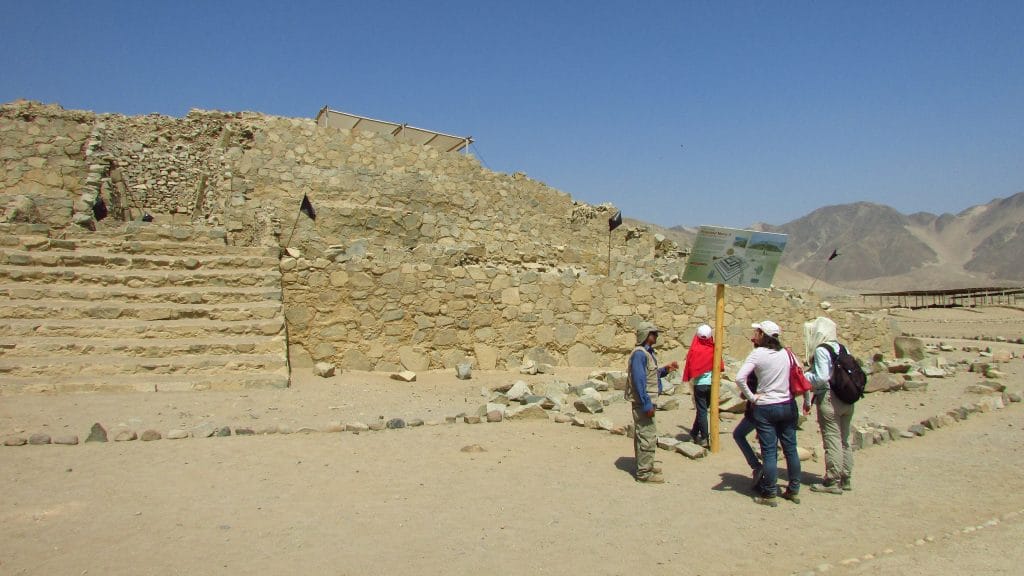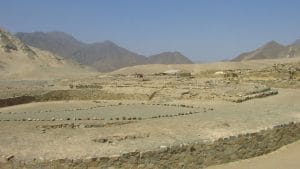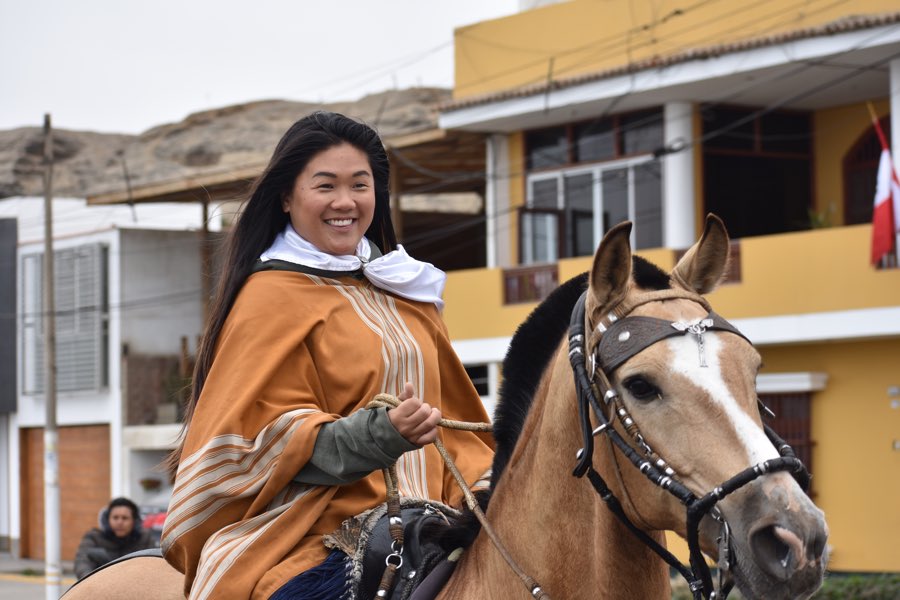Caral is considered the oldest civilization in America. It developed in the northern half of Peru. Today, we can visit the traces of this civilization in the Supe River Valley. Welcome to Barranca province, 185 km north of Lima, the capital of Peru.
We estimate that the Caral civilization developed between 2,600 and 1,500 years before Christ. Its origins date back to the Late Archaic Period of the Central Andes. With its almost 5,000 years old, it’s a contemporary of the civilizations of ancient Egypt, the Sumerians of Mesopotamia or the Indus civilizations.
The visit of the sacred city of Caral will undoubtedly represent one of the most incredible experiences during your trip to Peru. In addition, this 66-hectare site was declared a World Heritage Site by UNESCO in 2009.
1. The Valley of the Supe River
Local agriculture
The valley of the Supe River grows many passion fruits : the famous ‘maracuyas’. You can see everywhere the vines in which they grow. The latter extend so long that one makes them grow and fall along strings. Awesome! Avocados and asparagus are also part of the landscape.
Archaeological sites
Caral is definitely THE site in the region. But it is important to note that this is not the only archaeological site in the Supe Valley. In fact, this fertile valley was the habitat of several successive civilizations, from Caral to Chancay. You’ll find much archeology around.
First, on the Pacific coast, you will see the ruins of Aspero, an old fishing port. There are no less than 21 urban centers that occur in the Supe Valley along 45 km. Each one has monumental public buildings. These are usually made of stone and clay, while the residential parts are made of adobe and wood.
2. The visit of the Sacred City of Caral
The Caral civilization developed for almost 1,000 years. We recommend hiring a local guide for more information. It must be recognized that without a guide, this set will be a mystery.
Arrival to the site
You can reach the site’s parking area when the river is dry.
During the rainy season, you’ll have to park on the other side of the river. Then you walk about twenty minutes. At first, the acacia trees give shade but then it is the desert, ruthless.
The city has remained buried under the desert sand for thousands of years. Its disappearance is due to an extreme climate phenomenon, such as an earthquake, perhaps accentuated by an El Niño period, which is frequent in the region.
The upper part of Caral
This upper part includes several sets of public buildings. In the center is the central square, where the “Mayor” pyramid is located.
The pyramid “Mayor”
It is recognizable by everyone with its impressive stone architecture and its underground plaza. The latter, located in front of the pyramid, measures 15 m in diameter.
Looking to the south, the pyramid dominates the valley and the Supe River. This is probably the most important building of all in Caral. In any case, it is the highest, with its almost 30 m. The pyramid seems to preside thus the great central square towards which they turn all its structure and its main staircase.
Scientists discovered the body of a young person, who must have been approximately 19/20 years old. He had the fingers of his hand and his feet cut off. He certainly was sacrificed during a very specific ceremony for the life of the city.

The pyramid “La Galería”
This impressive building is the third largest in the entire site.
It is in this pyramid that they discovered a quipu: it’s the oldest quipu in America! But what does this archival mode, described as typically Inca, do in a building from more than 2000 years before the Incas? It seems that the Incas were inspired by this millennial way of “writing”.
There were also whale vertebrae, used during ritual ceremonies.
The monolith “La Huanca”
This 2.3 m high block is located in the plaza formed by the pyramids called “La Galería” and “La Huanca”. It seems to be its center of convergence.
Archaeologists believe that this stone should be associated with astronomical activities and ritual ceremonies.
To consider
- All these buildings, pyramids or other residential areas are oriented towards the central square of the site.
- The pyramids consist in several constructions. A level may have covered the previous level. In fact, we recognized 3 overlapping constructions that seem to mark 3 successive construction periods.
The bottom of Caral
In general, they are smaller buildings. It even seems that those buildings are oriented towards the top.
The temple called «the amphitheater »
This is one of the main constructions of this “lower” part. Surrounded by walls, its circular plaza is even larger than the “Mayor” pyramid, located at the top. They discovered some 32 flutes and a lot of other bugle-type instruments.
This temple called “the amphitheater” seemed to have social, religious and administrative functions. It could have been associated with musical activities in a ceremonial context. Maybe it was one of the main public buildings, if not the main building, for the ceremonies in the city of Caral.
About architecture, its structure is very interesting. It contains, for example, ventilation ducts for the fires in the ceremonial enclosures. There are also decorations in bas-relief.

3. Excavations in Caral
Discovered in 1905, Caral did not immediately receive the attention it deserved. One of the causes can be the lack of ceramics. Caral is actually a preceramic civilization.
This explains as well its exceptional state of preservation. It was not until the 1990s that excavations really started thanks to archeologist Ruth Shady Solis. Then they began to uncover walls, stairs, structures, objects … Today, the investigation continues. In 2015, the discovery of a mummy strengthened the historical interest of this region.
4. Life in Caral
Other ancient civilizations like Mesopotamia or Egypt were relatively “geographically” close to each other and could have contacts between them. Far from being in this situation, the civilization of Caral had to develop autonomously, isolated and separated from these other centers and continents by the oceans.
This “center of civilization” was made up of groups or families that had united around an organization, a hierarchy. We estimate that, in the best of its development, its population reached between 3,000 and 3,500 inhabitants.
It seems that this civilization lived on agriculture, the cotton culture and the trade with the coast.
The organization of the city
The sacred city of Caral has an area of 66 hectares, divided into several areas:
- public buildings / residential spaces
- top / bottom / periphery
This complex constitution results from a desired composition. In fact, according to the research carried out, the city was conceived as a calendar. Each public building was constructed according to an astral position defined in relation to a deity.
Caral has 7 pyramids on the top, 2 on the bottom and 33 temples of lower rank.
The food of the inhabitants of Caral
The development of the city of Caral was allowed, in particular, by its agricultural and fishing economy. Inhabitants of the coast caught anchovies, mussels. On the other hand, those who lived in the Supe Valley provided cotton, pumpkins, beans, sweet potatoes, squash, chili peppers or guavas.
Talking about the Caral diet is about a seemingly diverse and balanced diet. You had many commercial exchanges between the coast and the valley.
A rigorous political and social organization
The civilization of Caral was governed by strict rules of hierarchy and caste.
The inhabitants of the valley knew a strong organization in the urban centers: “pachacas“. Each had its own hierarchy, its own elites, its own leader. In front of all these centers was the “Huno” or Lord of the Valley. The latter had the following powers:
- direct the entire administration system
- regulate religious, social and economic activities
- guarantee the order and distribution of the land.
Near the religious buildings were the “accommodations” of influential people, built with quality materials. In contrast, there were constructions of smaller size and quality where the “people” of Caral lived.
The construction materials used for the dwellings allowed to determine the classes of the inhabitants of Caral.
We have found several construction techniques. The most widespread was the one known as “Quincha“. La Quincha mixes a wooden structure crossed with that of mud. They used “Quincha” for the homes of the “people”. Latercame a mixed technique with quincha and stone. To build the upper class houses, they were using stone.
The strength of religion
It is said that it was religion that made it possible to create the cohesion of society. But it is also on the basis of religion that pressure is exerted on the inhabitants. In any public or private activity, there was a religious aspect. Therefore, in each residence, some offerings were burned.
These religious practices were accompanied by music. This explains the many musical instruments that have been found, especially the flutes that were used as a collective material.
5. Scientific advances and the use of science in the time of Caral
Science and practices
In Caral, we have seen the development of knowledge as:
- engineering
- architecture
- astronomy
- weather forecast or climate change.
In addition, the inhabitants of Caral knew well:
- Fluid mechanics, as shown by circular parts with underground ventilation.
- The medicinal virtues of many plant species, which they use regularly.
It is they who invented the quipu, this encoded system of recording information.
Agriculture and irrigation
In this valley, people experimented new crops to diversify the diet. they created new cotton plants. They used cotton for fishing nets or clothing.
This has been possible thanks to its complex irrigation system. In fact, despite its position in the heart of the desert, Caral had many rivers. They brought water from the Andes through an irrigation system that allowed irrigation of the desert lands of the area. Certainly we have created here a kind of favorable oasis for agricultural activity.
6. Caral, an example of a peaceful city?
Until today, no military constructions or weapons have been discovered in Caral. The city seemed to live in peace with the other surrounding towns.
7. The legacy of Caral for later civilizations
Caral paved the way in social, political and religious organizations have crossed space and time. In fact, they were useful to most recent civilizations and influenced the Inca civilization some 4,400 years later.
You can see that, for example, in the:
- Terraces of cultures already present in the time of Caral and that are so characteristic of the Incas.
- Geoglyph realizations for the ritual and symbolic purposes found in the valley of Supe. The Nasca will use these kind of designs 3,000 years later.
- Famous coding system of knotted ropes, designed to record data and measurements, already existed in the time of Caral. This system will be used for thousands of years, until the end of the Inca Empire. It is known as quipu.
- Certain characteristics of the construction, present in the time of Caral and that is with the Incas. The Carals used decorations that are similar to those found in Kuélap, Amazonas Region, for example.
Visit Caral in the north of Peru means to discover the influences and legacies of a civilization on the following ones, including the Incas.
8. Get to Caral
Actually, there are 2 possible accesses to Caral:
- From Huacho, from the south. However, the road is not always passable, especially in the rainy season.
- From Barranca then following Supe valley. This access is open all year.
To get there, we decided to spend the night in Barranca. This peaceful coastal city is full of life, some would say noisy, and is about 25 km from Caral.
The journey Lima to Barranca
For this trip, we chose the company Moviltours.
Our bus is waiting for us at the Moviltours station. This is located in the express way in Lima, near the Stadium. The ticket to Barranca this Sunday during Easter weekend is 20 soles per person. We have about 200 km to go. Leaving Lima Station at 2.00 p. M., The bus arrives in Barranca at 6.00 p.m.
Barranca, coastal city
Second mission: find a hotel. On the ocean coast, Barranca is an active, rather noisy city, it’s true. However, it is nothing for those who frequent cities such as Piura or Tarapoto. Here, too, hundreds of moto-taxis and taxis continuously honk the horn to get your attention and propose you a ride.
The hotel offer is not lacking in Barranca, from economical to the 3 stars. At the opposite, about restaurant, it’s quite confusing! In fact, we are on the sea shore, but what do they offer you? Chicken restaurants on the grill. Upon arrival, we can see large chicken farms. We opted for a simple little restaurant but where we can taste an excellent fish in tomato sauce called “sudado”.
For those who prefer the coast, it is possible to take a moto-taxi to go near the ocean and enjoy the fish restaurants.
We booked a shuttle the next morning to go to Caral.
How to get to Caral from Barranca
You can rent a taxi service for just over 100 soles. He takes you and usually waits for you there. This can be profitable when you are 3 or 4 because he goes when you decide.
Other public transports offer the Barranca-Caral race for 25 soles per person. But, like all public transport, its goal is to travel full. This can generate some discomforts.
We decided to take a public transportation. However, getting out full is an almost impossible mission on this day right after Easter week-end. After picking us up at the hotel 30 minutes late, he stops at Supe. He expects hypothetical clients in this neighboring town of Barranca. On my insistence, we finally go to Caral.
It takes almost 1 hour to get to Caral, although a little less than 30 km from Barranca. This is due to the condition of the road.
9. Some practical tips to visit Caral
Do not forget to bring:
- a hat
- a long sleeve shirt
- sunglasses
- a bottle of water
- sunscreen
Caral is only at 350 m above sea level. The light is bright and it’s very hot in the valley of Supe.



